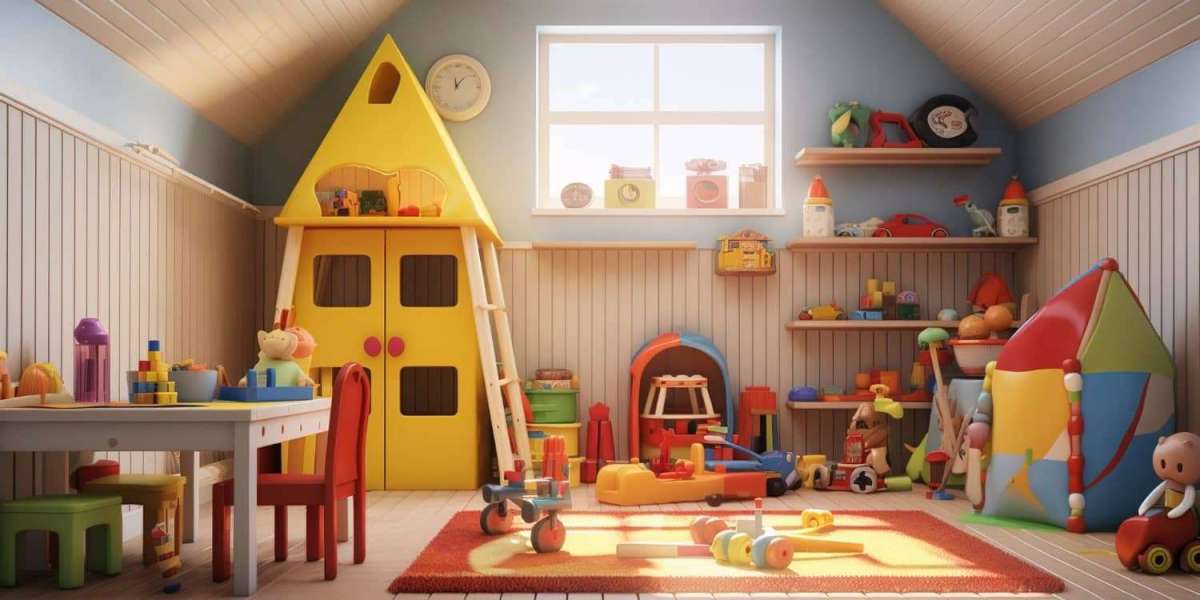MONTESSORI PLAYROOM
Montessori playrooms are great places for kids to play and learn. They're clean, simple, and lots of fun. A good Montessori playroom can help your child focus better and become more independent from a young age.
This article will explain all about Montessori playrooms and how they work. It will also guide you in setting up your own Montessori playroom at home for your child.
WHAT IS A MONTESSORI PLAYROOM?
A Montessori playroom is a special space for kids, planned to help them be more independent and focused. It's tidy and straightforward, with just the right toys for their age.
Full shot cute kid drawing at table
Every toy in a Montessori playroom is made to help kids learn skills such as moving small and large muscles. This turns playtime into more than just fun; it becomes really interesting and helps them grow.
These are some of the key features or characteristics of a Montessori playroom:
It only has a few toys and activities. Each thing in the playroom is picked for a good reason.
- It uses furniture that's just the right size for kids, so they can easily get to everything.
- It's made to be a comfy place that your child loves spending time in.
- There's some empty space for your child to play freely.
- The toys are chosen to keep your child interested, not just entertained.
- Everything has its own spot, so it's easy to keep things tidy. When playtime is done, everything goes back where it belongs.
- It offers different activities for your child to try out.
HOW SHOULD A MONTESSORI PLAYROOM BE SET UP?
Here's how you can create your own Montessori playroom at home:
Keep it simple
Keep it simple. Choose just a few toys and activities for your child. This helps them concentrate on a few things and get really good at them, instead of getting distracted by lots of toys and activities.
Most Montessori guides suggest having around 8-10 activities in the playroom. If you have more than 10 toys, try rotating them weekly to keep your child interested. If you see your child particularly enjoying certain toys, leave those out and switch the others. This way, your child can become really good at playing with all their toys.
You might observe that many Montessori playrooms opt for neutral colors instead of bright ones commonly found in children's play areas. This creates a calming atmosphere that helps enhance concentration.
Use child-height Montessori furniture to keep things at their height
Make sure everything your child uses is within their reach. Montessori furniture and shelves can help with this by keeping everything at their height. This way, your child can easily see and grab what they want, and put it back when they're finished.
Don't hide their toys in a box. Keep everything out where they can see it. If you want to add flowers, plants, or art to their playroom, make sure these are also at their eye level so your child can enjoy them.
In addition to shelves, consider adding a table and chair that are just the right size for your child. This way, they can choose whether to play on the floor or at the table, especially for activities like puzzles.
Include nature in the space
Whenever you can, pick a room with lots of natural light. This allows your child to explore shadows, play with the sunlight as it changes, and observe nature, like watching the rain.
When your child can see out of a window, it gives them a chance to talk about what they see. If the window is too high, and it's safe to do so, you can give them a step stool so they can look out and explore the world around them.
Try to have plants and pets in the playroom when possible. Hanging plants and herbs work well for this. Choosing the right houseplant can also teach your child to care for something, while adding beauty to the room.
Younger kids can observe simple pets like fish swimming around, while older ones can take care of them too.
Allow open space for movement
Having an open area in the playroom is excellent for improving gross motor skills. Give them plenty of room to move, climb, and explore. This kind of activity is really important for kids as they grow. It's best to put this space in the middle so your child can easily access their activities. You could also get some comfy cushions that can be moved to make different setups.
If you're short on space, the open area doesn't necessarily have to be within the playroom. You can set it up anywhere else in the house, as long as your child has the chance to develop their gross motor skills.
Invest in toys that promote engagement over entertainment
In many Montessori playrooms, you'll find mostly wooden toys. Wooden toys and those made from natural materials are not only eco-friendly and attractive but also durable. However, the primary reason Montessori playrooms avoid plastic, battery-operated toys that produce noise and light is that while the latter can entertain children well, the former fosters deeper engagement.
In fact, many Montessori toys are more engaging than plastic ones. And, you also gain additional developmental advantages when you opt for them.
As you choose activities for your child's Montessori playroom, make sure to pick them carefully and include a range of options.
If you're on a tight budget, you can still purchase plastic toys that fit within your means. Just ensure you select them thoughtfully, opting for toys that offer benefits to your child beyond mere entertainment.
Alternatively, if you prefer not to spend money on toys, you can engage in DIY activities with your child using materials you already have at home. These homemade activities can also be highly beneficial for your child's development.
Create order and routine by giving everything its own place
Montessori often discussed "sensitive periods," which are specific times when a child is particularly drawn to something and eager to learn about it. There's a sensitive period for order in children from early toddlerhood up to around age five. During this time, they enjoy routine and repetition. Just as they appreciate order in their lives, they also desire order in their surroundings. However, they may need some assistance in achieving this.
Your Montessori playroom should cater to this need for order by designating a specific space for each item. When everything in your child's playroom has its own place, it provides them with a sense of comfort and familiarity, knowing exactly where to locate each item.
Furthermore, instilling order and routine is an effective method for teaching your child how to tidy up after themselves. When they are aware of the specific place where each toy belongs on the shelf, they are more inclined to return them to the same spot once they are finished, and they might even find satisfaction in doing so.
Ultimately, you won't have a disorganized playroom with toys strewn about!
Mix the activities up
The best Montessori playroom offers a range of activities for the child to select from. Incorporate a diverse array of toys to enable your child to develop different skills each week.
This doesn't imply that every toy you display must target a specific skill. It's about watching your child and discovering what interests them the most. If they enjoy puzzles, it's fine to offer two or three extra puzzles. If they struggle with a reading toy because they're not quite ready for it, consider putting it away for a few weeks.
It's about discovering your child's favorite activities through observation and encouraging them to do more of what they enjoy.
Make it a cozy space that your little one will enjoy to spend time in
Each Montessori playroom will have its unique appearance. Consider painting the walls with a soothing color and maximizing natural light if possible. You might include a cozy couch, cushions scattered around, or a soft mat where they can relax and read.
Adding some artwork and a couple of plants will also bring vitality to the room. Remember, everything should be accessible for your child. If you display artwork, ensure it's at your child's eye level so they can enjoy it fully.
Ultimately, you're the one who understands what will resonate with your child. There's no one-size-fits-all formula for creating a cozy Montessori playroom—simply do what suits you best!
WHAT SHOULD A MONTESSORI PLAYROOM INCLUDE?
The key consideration in setting up your Montessori playroom is diversity. Here are some items to consider including:
- Open Area: If available, designate an open area for free play, movement, and exploration.
- Artwork: Consider your child's preferences. For infants, black and white images are stimulating. As they grow, introduce nature scenes, their own creations, family photos, interesting maps, and diverse art pieces. Place all artwork at eye level for the child.
- Montessori Furniture: Opt for child-sized furniture, especially shelves, tables, and chairs.
- Nature: Integrate nature into the space by ensuring ample natural light and incorporating accessible houseplants. Consider introducing simple pets like fish or turtles.
- Activities: Provide a variety of activities to encourage mastery of diverse skills.
WHAT TYPE OF FURNITURE IS GOOD FOR A MONTESSORI PLAYROOM?
The best type of furniture for a Montessori playroom is child-sized Montessori furniture, crafted to empower children to develop independence and responsibility in their environment.
Montessori furniture is ideal for playrooms because it's highly adaptable and versatile. When children engage with these pieces, they enhance their self-confidence, independence, and critical skills as they navigate their surroundings.
Encouraging independence from a young age lays the foundation for future success. Children learn to embrace new challenges confidently on their own.
At the very least, think about acquiring a bookcase or shelving unit and a table and chair set sized for children.
WHAT ARE GOOD MONTESSORI TOYS?
Toys play a significant role in every Montessori playroom. So, what should you choose?
The best Montessori toys adhere to Montessori principles. They are uncomplicated, crafted from natural materials, and inspire creativity and exploration. They offer versatility in their usage, and numerous Montessori toys are suitable for infants as well.
Quality Montessori toys evolve with your child, allowing them to uncover new uses and applications as they develop and acquire new skills.
So, how do you determine if a toy aligns with Montessori principles? Here are some key attributes of top-notch Montessori toys. Aim to find one that meets as many of these criteria as possible:
- They're simple: They can be as basic as three shapes in three colors to teach your child about shapes and colors.
- They're based on reality: Young kids can't tell fantasy from reality yet. To develop their imagination, they need to understand the real world. Instead of toys with random noises, choose ones that show real-world effects, like a ball rolling down a ramp.
- They're made of natural materials: Wood and metal have more variety than plastic. For example, wooden balls are lighter than plastic ones. Your child learns more from natural materials.
- They need child involvement: Your child gets to actually play with them instead of just pushing a button and watching.
- They offer many play options: They're purposely open-ended so your child can make up their own rules and ways to play.
WHAT ACTIVITIES CAN A KID DO IN A MONTESSORI PLAYROOM?
There's a broad array of activities you can engage in with your child in the Montessori playroom. Just make sure to include variety in them.
Toy Play: Choose toys that aid in your child's development, targeting various skills such as concentration, problem-solving, and both fine and gross motor skills.
Puzzle Play: Older children particularly enjoy puzzle activities, and you'll likely see their interest grow with time. It's best to provide a table and chair for this activity. If you notice your child becoming more interested in puzzles, consider adding additional puzzles to their weekly toy rotation the next week.
Life Skills Practice: These skills can be learned not only in the playroom but also throughout the home. Tasks such as hand-washing, sweeping, putting toys away, general tidying, and basic self-care activities like blowing noses and brushing hair all fit into this category.
Language Activities and Books: Younger babies enjoy black and white picture books, while older babies can explore colorful ones. Ensure all their books are easily accessible at all times.
Children's Light Table: A light table offers countless chances for kids to discover everyday items in fresh ways. Backlit objects like feathers and leaves spark wonder in children. Plus, it enhances the enjoyment of playing with translucent building toys such as Magna-Tiles® and LEGO®! Explore more about a children's light table.
Musical Instruments: Create a music area with basic instruments such as drums, shakers, and xylophones. If your child shows interest in music, gradually introduce more instruments and consider enrolling them in classes as they get older.
Art and Crafts: This is a wonderful activity to enjoy together. You can display their completed artwork in the playroom afterward.
HOW SHOULD THINGS BE STORED IN A MONTESSORI PLAYROOM?
In the Montessori playroom, everything should be organized and have its designated spot. Toys should be neatly stored on their assigned shelves. It's helpful to rotate toys weekly or every other week to keep the environment dynamic and engaging.
When rotating the toys, introduce the new toy to your child, demonstrate how it functions, and show them where it belongs on the shelf. Teach them how to return it to its place once they've finished playing with it.
The playroom shouldn't be overcrowded with an excessive number of toys and activities.
Here are some additional tips to assist you in organizing the playroom:
- Label them: If you store Montessori toys in boxes elsewhere in the house for future rotations, consider labeling them to identify the developmental benefits of each toy. Use index cards instead of writing directly on the boxes for greater reusability.
- Utilize baskets or trays if shelving is unavailable.
- Utilize higher shelves for storage: Place toys not currently in use on the top, hard-to-reach shelves. Since your child won't access them, keep these toys out of sight in boxes for later rotations.
- Be innovative: As with all things Montessori, prioritize finding a system that suits you and adapt it to your needs.
FINAL THOUGHTS
That's quite a bit of information to absorb, isn't it? The great news is that when designing your child's Montessori playroom, you have the flexibility to choose what suits your needs.
There's no strict rule for setting up your Montessori playroom. If you already have a playroom, simply ensure everything is accessible to your child and limit activities to around 8 to 10. Then, incorporate developmental toys that encourage engagement, and you're all set!
Remember, it's not an all-or-nothing situation. You don't have to exclude your child's favorite plastic toy car if that's what they enjoy. You know your child best, so do what feels right for you. Best of luck!
SHIR-HASHIRIM MONTESSORI: LA’S BEST MONTESSORI PRESCHOOL SINCE 1985
They're dedicated to helping your child reach their full potential by providing practical assistance and support. With 40 years of experience in nurturing young minds, they prioritize teaching essential academic and life skills in fun, interactive ways. Don't hesitate to contact them anytime if you have questions or want to learn more about their programs.
Disclaimer: Shir-Hashirm Montessori does not have any sponsorship or affiliation with the brands mentioned above. The purpose of this informative blog is to provide valuable insights into some of the best Montessori toys available.








